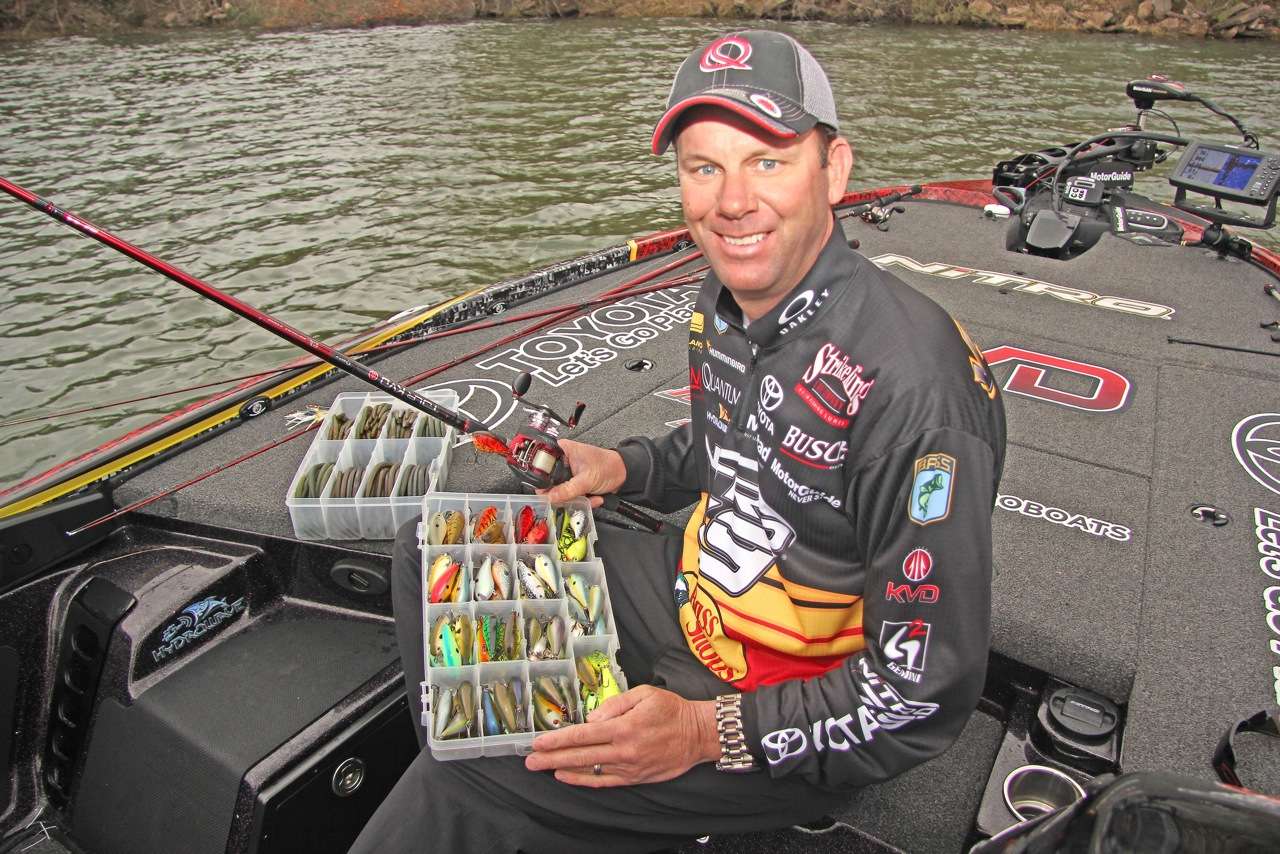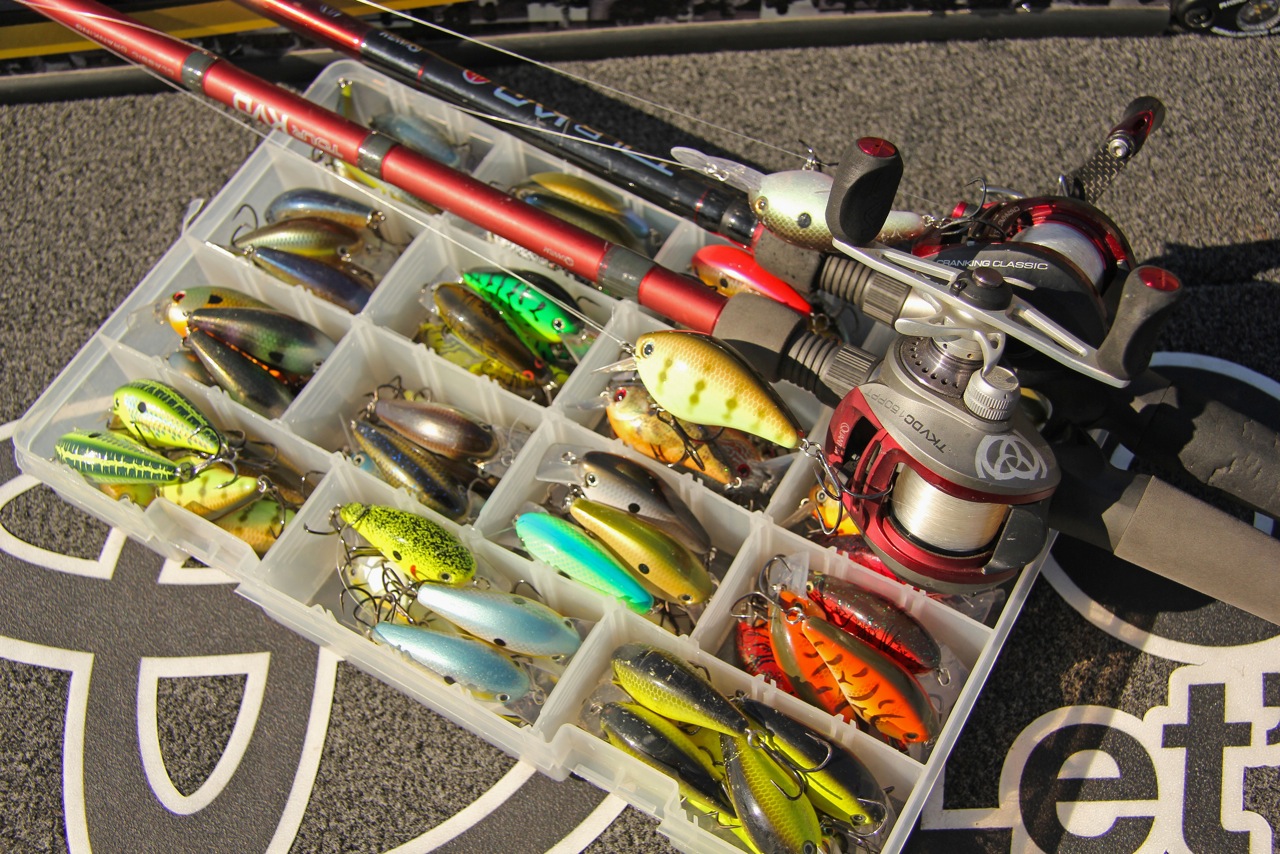
If you think Sexy Shad is Kevin VanDam’s favorite crankbait color, you’d be right … but only a third of the time. “Sexy shad is awfully good in a lot of situations, but I only choose it about 30 percent of the time, based on its fit for the conditions,” says VanDam. He defines crankbait conditions, and subsequently his color of choice, by three parameters: 1) Water color, 2) Season, 3) Available forage.
Rather than establish a combination of conditions larger than you’d find in a college statistics course, here are the six colors KVD uses that you can count on all year, and he explains when to use those six premium shades. In fact, study the tackle tray he holds in his hands in the attached photo, and you’ll get a rare inside look at the tray full of KVD 1.5 crankbaits he actually carries in his boat. Kevin says it includes all you’ll ever need for shallow cranking. It’s the very tackle tray he’ll fish from all year.
- Orange/Red Craw patterns – I throw the craw patterns in the earliest part of spring, no matter what the water clarity is.
- Chartreuse/Black Back – My top choice for dirty water all year long. Also a top pick during the spawn when the water is heavily stained. I also use this color in postspawn conditions in off-colored water that is stained or dirty to the point that you can’t see the lure more than 12 to 18 inches below the surface.
- Bluegill – My favorite color around the spawn, as long as the water is clear to the point you can see the lure at least 18 to 24 inches beneath the surface.
- Sexy Shad – The best color when the water has a pretty heavy or darker green tint to it, to the point of being stained, and the shad are the predominant forage.

- Summer Sexy Shad – This is a subtle version of sexy shad that I use largely during the warmest time of the year, as its name suggest, when the water is pretty clear, rather than heavily stained, and shad are present.
- Green Gizzard Shad – This is a little better choice than plain ol’ Sexy Shad if the water is really, really clear and there are plenty of shad.
Color is critical to crankbait fishing success. But Kevin describes his approach to the diving bill family of baits as a “system.” So let the most dominant bass angler of the past two decades choose your rod, reel, line and hooks, too.
- Rods: Kevin was the primary architect in the highly specific design of seven rods, all suited for crankbait fishing. But if he had to choose just one, it would likely be the 7-foot TKVD705MA. A longer rod allows for longer casts. When he’s fishing farther back into the creeks around thick logs and laydowns, he’ll use a 6’6” (TKVD664MA). A shorter rod allows him to be more precise.
- The reel remains the same: Whether it was the 2010 season, when KVD had an economic stimulus plan of his own – cashing fat checks totaling more than $900,000, or the 2011 Bassmaster Classic where he cranked record winning weights from a New Orleans Delta stump field … he won ‘em all with a 5.3:1 ratio Quantum PT Cranking Classic casting reel. It features oversized gears, and a big 150-sized spool that’s handy for extra long casts. “Because of the spool size of that reel (TKVDC150PPT), it’s really not what I consider a slow reel, but it’s not so fast that I lose control. The 5.3:1 ratio is ideal for crankbaits in my opinion, whether I’m deep cranking or working thick, shallow cover,” he explains.
- Line and Hooks: “I throw Bass Pro Shops’ 12-pound XPS fluorocarbon in clearer water, and if I’m cranking in shallow off-colored or dirty water, then I’ll use 17-pound XPS. The hooks are critical to me, too. I always replace factory hooks with Mustad’s KVD Elite short shank treble hooks. I usually put a fresh set of those hooks on my crankbait several times a day – it pays off,” insist VanDam.
“To be successful, you have to fish with the color the conditions call for. You can’t fish with your favorite color all the time,” says VanDam. Not even Sexy Shad.





